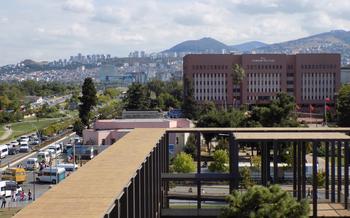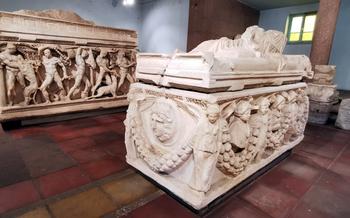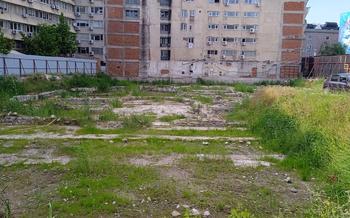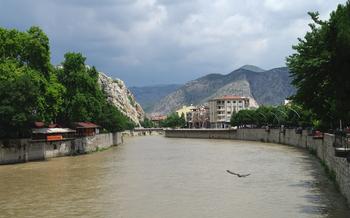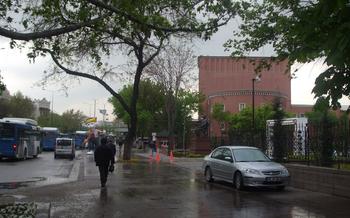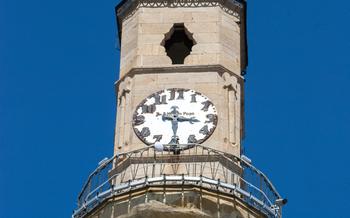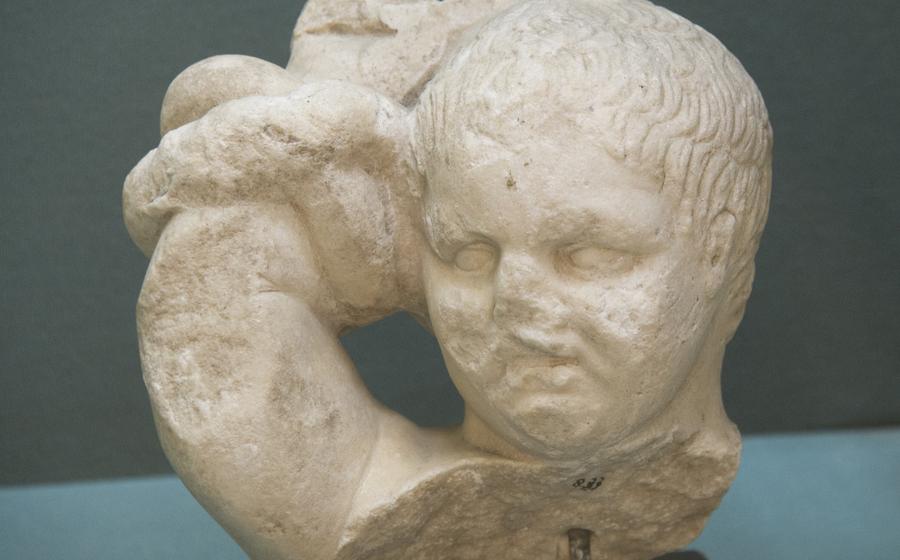
Kütahya Archaeology Museum
- The Antiquity of Kütahya:
- Kütahya Archaeology Museum: A Treasure Trove of History
- Unveiling the Secrets of the Past
- A Legacy of Ceramics and Handicrafts
- Exploring the Museum's Highlights
- A Journey into Anatolian Civilizations
- Interactive and Educational Exhibits
- Preserving Cultural Heritage
- Local Cuisine and Hospitality
- Souvenirs and Handicrafts
- A Photographic Journey
- Accessibility and Facilities:
- Insider Tip: The Secret of the Phrygian Treasure
The Antiquity of Kütahya:
Kütahya, a city in western Turkey, boasts a rich and diverse history that spans several millennia. Archaeological discoveries have revealed that the region was inhabited as early as the Neolithic period, with settlements dating back to 7000 BC. The city's strategic location at the crossroads of ancient trade routes made it a melting pot of cultures, with influences from the Hittites, Phrygians, Greeks, Romans, Byzantines, and Seljuks. Each of these civilizations left its mark on Kütahya, contributing to its unique cultural heritage. The city's name itself is derived from the ancient Persian word "kuta," meaning "fortress," a testament to its historical significance as a fortified settlement.
Kütahya Archaeology Museum: A Treasure Trove of History
Established in 1963, the Kütahya Archaeology Museum stands as a testament to the region's rich cultural heritage. Its mission is to preserve, study, and exhibit artifacts that shed light on the diverse civilizations that have flourished in Kütahya throughout history.
The museum's collection is a treasure trove of archaeological finds, meticulously organized in chronological order to provide visitors with a comprehensive journey through time. From the earliest settlements to the Ottoman era, each exhibit tells a captivating story of the region's past.
The well-preserved and informative displays enhance the visitor experience, offering detailed descriptions and historical context for each artifact. Interactive exhibits and multimedia presentations bring the exhibits to life, making the museum a dynamic and engaging learning environment.
Unveiling the Secrets of the Past
The Kütahya Archaeology Museum houses a captivating collection of artifacts that unravel the rich history of the region, taking visitors on a journey through the ages. Among the remarkable finds are Neolithic and Chalcolithic tools and pottery, offering glimpses into the earliest human settlements in the area. These artifacts provide valuable insights into the daily lives, technologies, and artistic expressions of our distant ancestors.
The museum also boasts an impressive array of Bronze Age artifacts, showcasing the region's advanced craftsmanship during this period. Tools, weapons, and pottery from this era reveal the sophisticated skills and techniques of the ancient inhabitants. The intricate designs and decorations on these artifacts hint at the cultural and artistic influences that shaped the region during the Bronze Age.
Moving forward in time, the museum's Hellenistic and Roman collections showcase the profound impact of these civilizations on Kütahya. Sculptures, coins, and pottery from this period reflect the region's integration into the broader Mediterranean world. Visitors can admire the influence of Greek and Roman artistic styles, as well as the unique blend of local traditions that emerged during this time.
Finally, the museum's Byzantine and Seljuk artifacts provide a glimpse into the region's religious and political transformations. From intricately carved religious icons to architectural elements, these artifacts showcase the artistic achievements and cultural diversity that characterized these periods. The museum's collection offers a comprehensive narrative of the region's past, allowing visitors to delve into the fascinating stories of the civilizations that have shaped Kütahya's rich heritage.
A Legacy of Ceramics and Handicrafts
Kütahya is renowned for its exquisite ceramics and handicrafts, which have earned it a reputation as a center of artistic excellence. The Kütahya Archaeology Museum proudly showcases the region's rich ceramic heritage through a captivating collection of tiles, pottery, carpets, kilims, metalwork, and jewelry.
Among the highlights of the ceramic collection are the Kütahya tiles, which are celebrated for their intricate designs, vibrant colors, and exceptional craftsmanship. These tiles have adorned mosques, palaces, and other significant buildings throughout the region, leaving a lasting legacy of artistic beauty.
The museum also houses a diverse range of pottery, from delicate hand-painted pieces to large storage vessels. These artifacts provide a glimpse into the daily lives of past civilizations, revealing their culinary practices, storage techniques, and artistic preferences.
The intricate carpets and kilims on display showcase the region's rich textile traditions. These finely woven textiles feature geometric patterns, floral motifs, and symbolic designs, reflecting the cultural heritage and artistic sensibilities of the local artisans.
Furthermore, the museum exhibits a collection of metalwork and jewelry that demonstrates the skill and artistry of local craftsmen. From intricate silver filigree to finely crafted gold jewelry, these artifacts showcase the region's mastery of metalworking techniques.
Exploring the Museum's Highlights
Among the museum's many treasures, the collection of Phrygian artifacts stands out for its exquisite craftsmanship and historical significance. Phrygian sculptures, with their intricate details and expressive faces, offer a glimpse into the artistic prowess of this ancient civilization. Jewelry made of gold, silver, and semi-precious stones showcases the Phrygians' mastery of metalworking and their love of adornment. Inscriptions in the Phrygian language provide valuable insights into their written communication and cultural practices.
The Roman mosaics, with their vibrant colors and intricate designs, transport visitors back in time to the grandeur of the Roman Empire. Depicting scenes from mythology, daily life, and religious ceremonies, these mosaics offer a fascinating glimpse into the Roman worldview and artistic traditions.
Islamic ceramics, with their intricate patterns, vibrant glazes, and calligraphic inscriptions, reflect the region's rich artistic heritage and the influence of Islamic culture. These ceramics, ranging from simple household items to elaborate decorative pieces, showcase the skill and creativity of local artisans.
Medieval manuscripts, with their illuminated pages and intricate calligraphy, provide insights into the intellectual and religious life of the past. These manuscripts, often commissioned by wealthy patrons, contain texts on a variety of subjects, including history, religion, literature, and science.
Coins from various periods, including the Hellenistic, Roman, Byzantine, and Seljuk eras, offer a glimpse into the economic life of the region and the different currencies that were used throughout history. These coins, often bearing the effigies of rulers or symbols of the state, provide valuable information about the political and economic history of Kütahya and its surrounding regions.
A Journey into Anatolian Civilizations
The Kütahya Archaeology Museum offers a unique opportunity to trace the development of Anatolian civilizations from prehistoric times to the present. Visitors can admire the diverse artistic expressions of different cultures that have shaped the region, gaining insights into the daily lives, beliefs, and customs of ancient Anatolian societies.
The museum's exhibits showcase the rich legacy of Phrygians, Romans, Byzantines, Seljuks, and Ottomans, providing a comprehensive overview of Anatolian history and culture. Through the artifacts on display, visitors can trace the evolution of artistic styles, technological advancements, and social customs that have left an indelible mark on the region.
The museum's collection offers a glimpse into the vibrant tapestry of Anatolian culture and its profound influence on world civilization. From the intricate designs of Phrygian jewelry to the stunning mosaics depicting Roman mythology, the exhibits showcase the creativity and artistry of Anatolian artisans throughout history.
Interactive and Educational Exhibits
The Kütahya Archaeology Museum takes pride in its commitment to providing an engaging and educational experience for visitors of all ages. To this end, it has incorporated several interactive and educational elements into its displays. Multimedia screens and interactive exhibits bring the past to life, allowing visitors to explore the museum's collection in a dynamic and immersive way. Educational programs and workshops are regularly organized to cater to different age groups and interests, providing opportunities for hands-on learning and deeper engagement with the museum's artifacts and themes. Guided tours are also available, offering visitors in-depth knowledge and insights into the museum's collections. Through these initiatives, the museum plays a vital role in promoting cultural awareness and education in the community, inspiring a new generation to appreciate and safeguard their cultural heritage.
Preserving Cultural Heritage
The Kütahya Archaeology Museum plays a pivotal role in preserving and protecting the region's rich cultural heritage. It serves as a custodian of invaluable artifacts and antiquities that tell the story of Kütahya's diverse past. The museum's dedicated team of conservators and curators works tirelessly to conserve and restore these precious objects, ensuring their accessibility to future generations.
Preserving cultural heritage is of paramount importance for local identity and tourism development. The museum's collection serves as a tangible link to the region's history and traditions, fostering a sense of pride and belonging among the local community. Moreover, the museum attracts visitors from around the world, who come to admire the unique artifacts and gain insights into the region's rich cultural tapestry. This cultural tourism not only generates revenue but also contributes to the preservation and promotion of local heritage.
However, managing and promoting cultural heritage in a changing world presents challenges and opportunities. The museum must strike a balance between preserving the authenticity of its collection and adapting to the evolving needs of visitors. This includes incorporating modern technologies to enhance the visitor experience, developing educational programs to engage younger generations, and collaborating with other institutions to promote cultural exchange and research.
Overall, the Kütahya Archaeology Museum stands as a testament to the enduring legacy of Anatolian civilizations. Its commitment to preserving and showcasing the region's cultural heritage makes it an invaluable resource for scholars, visitors, and the local community alike.
Local Cuisine and Hospitality
Enhance your cultural immersion in Kütahya by savoring the delectable flavors of traditional Turkish cuisine. Step into local restaurants and cafes near the museum to experience the warmth of Turkish hospitality. Indulge in mouthwatering dishes that reflect the region's rich culinary heritage, from succulent kebabs to aromatic stews. Engage with friendly locals, eager to share their stories and provide recommendations for must-try culinary delights. Don't miss the opportunity to savor the authentic flavors of Turkish coffee, a beloved beverage deeply ingrained in the country's culture. As you savor the delicious offerings, you'll gain a deeper appreciation for the vibrant tapestry of Turkish cuisine and the welcoming spirit of the local people.
Souvenirs and Handicrafts
After delving into the rich history and cultural heritage of Kütahya at the Archaeology Museum, visitors may want to take a piece of the experience home with them. The city is renowned for its vibrant handicrafts and traditional arts, offering a treasure trove of unique souvenirs to cherish.
Local Shops and Markets:
Kütahya's bustling markets and shops offer a delightful array of locally crafted goods. From the renowned Kütahya tiles with their intricate designs and vibrant colors to hand-woven carpets and kilims showcasing the region's rich textile heritage, there's something for every taste and budget.
Supporting Local Artisans:
By purchasing souvenirs from local artisans, visitors not only take home a piece of Kütahya's cultural heritage but also contribute to the preservation of traditional crafts. The vibrant colors and intricate patterns of these handcrafted items reflect the skill, artistry, and dedication of local artisans.
Unique Souvenirs:
When selecting souvenirs, consider items that truly represent the region's cultural heritage. Look for hand-painted ceramics, intricately carved wooden objects, or delicate metalwork that showcase the unique artistic traditions of Kütahya.
Bargaining Tips:
Don't hesitate to engage in friendly bargaining with local vendors. This is a customary practice in Turkish markets, and it's an opportunity to strike a fair deal while showing respect for the artisan's work.
A Photographic Journey
The Kütahya Archaeology Museum is a treasure trove of visual delights, providing ample opportunities for photography enthusiasts to capture the beauty and essence of ancient artifacts and exhibits. With the right equipment and techniques, visitors can create stunning images that not only document their visit but also serve as a lasting reminder of the region's rich cultural heritage.
Tips for Taking Stunning Photos:
-
Use natural light: The museum's well-lit galleries and courtyards provide ample natural light, which is ideal for capturing the true colors and textures of the artifacts. Avoid using flash, as it can create harsh shadows and reflections.
-
Compose your shots carefully: Take the time to compose your shots carefully, ensuring that the artifacts are the focal point of the image and that the background is not distracting. Experiment with different angles and perspectives to create dynamic compositions.
-
Pay attention to detail: The museum's exhibits are full of intricate details, so take the time to zoom in and capture the finer points. Close-up shots of inscriptions, carvings, and decorative motifs can reveal hidden stories and enhance the impact of your photographs.
-
Experiment with different lighting: If possible, visit the museum at different times of the day to capture the changing light conditions. The warm glow of the morning or evening sun can create a unique and atmospheric look for your photos.
-
Share your photos: Don't forget to share your photos on social media and inspire others to visit the Kütahya Archaeology Museum. Use hashtags related to the museum and the region to connect with other photography enthusiasts and share your experiences.
Accessibility and Facilities:
The Kütahya Archaeology Museum is committed to providing a welcoming and accessible environment for all visitors. The museum features ramps, elevators, and accessible restrooms, ensuring that individuals with disabilities can navigate the museum with ease. For visitors with hearing impairments, assistive listening devices are available upon request. Additionally, the museum provides tactile exhibits and large-print labels for visitors with visual impairments.
Families with young children can take advantage of the museum's stroller-friendly layout and designated changing areas. To engage younger visitors, the museum offers interactive exhibits, educational programs, and family-friendly workshops.
For those seeking a moment of respite, the museum offers comfortable seating areas and a café where visitors can relax and enjoy refreshments. Whether you're a history buff, a casual visitor, or someone with specific accessibility needs, the Kütahya Archaeology Museum is designed to provide a memorable and enriching experience for all.
Insider Tip: The Secret of the Phrygian Treasure
Among the many treasures housed within the Kütahya Archaeology Museum, there lies a hidden gem known as the Phrygian Treasure. This remarkable collection of artifacts, discovered during excavations at the ancient Phrygian capital of Gordion, offers a glimpse into the opulence and artistry of this enigmatic civilization. From intricately crafted gold jewelry to beautifully preserved bronze vessels, the Phrygian Treasure provides a tangible connection to the past and unveils the secrets of a lost world. To fully appreciate the splendor of this collection, be sure to seek out the dedicated Phrygian gallery within the museum. Immerse yourself in the history and culture of this ancient kingdom as you marvel at the exquisite craftsmanship and artistry on display. The Phrygian Treasure is a testament to the enduring legacy of this once-powerful civilization and a must-see for any visitor to the Kütahya Archaeology Museum.

